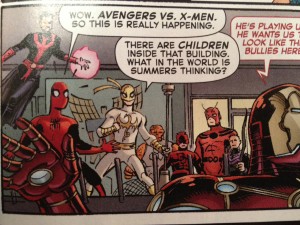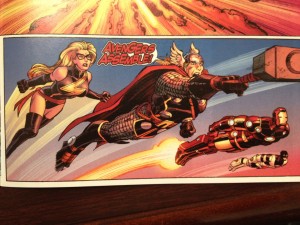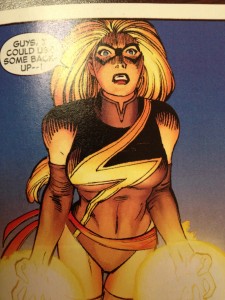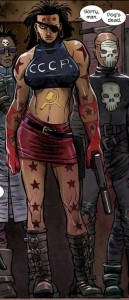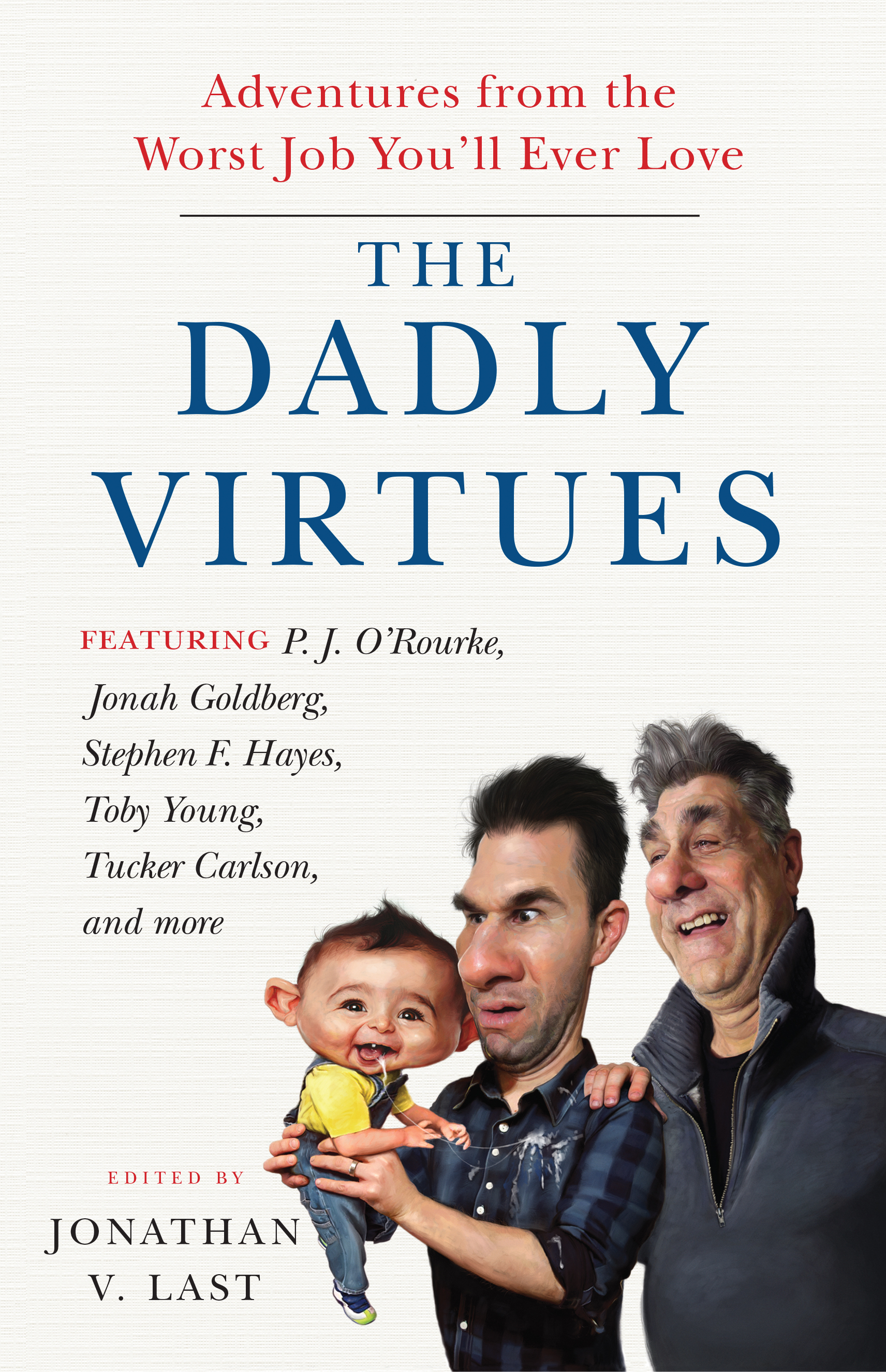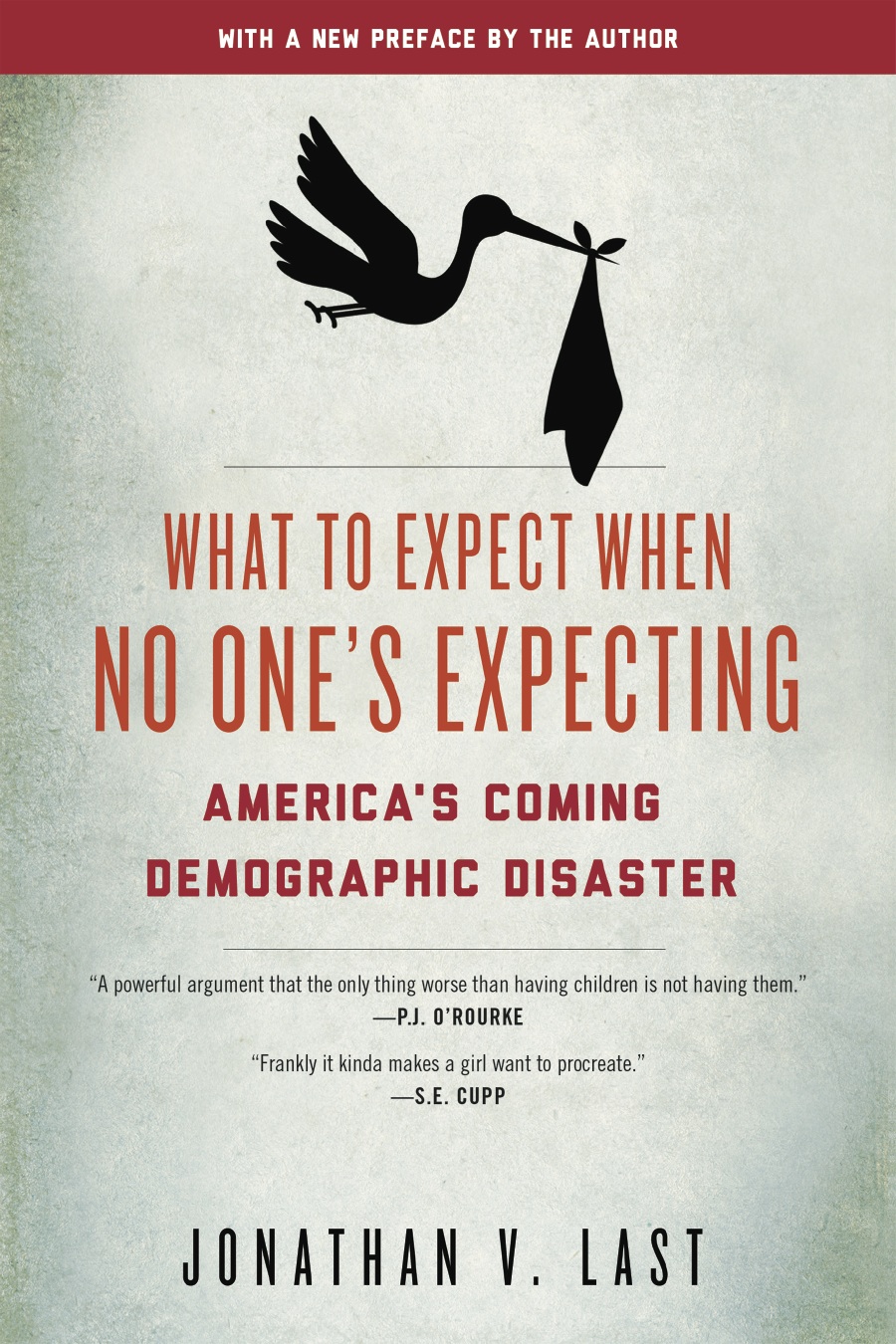April 25th, 2012
Marvel has been pushing this year’s big event series, Avengers vs. X-Men, as hard as they’ve pushed anything since Civil War. Three issues in, it’s not surprising to report that the series is . . . underwhelming. Even by the standards of Event Comics. (Whoever thought we’d look back on Civil War as an example of reasonably well-executed, commercialized plot-shifting?)
I’m not totally shocked that the writing is stiff and bloated–the thing has five credited writers. But what really has surprised me about the A vs. X books is how embarrassingly sloppy the art is. This is Marvel’s long-gestating, summer mega project and the product that will be there to capitalize on an Avengers moviegoers who decide to try taking a dip into comics. And it features panels like this:
Check out Spidey’s neck there. Click to enlarge and really see how tossed-off those pencils are. Then there’s this:
Thor’s face is like, what? And then there’s this Ms. Marvel:
Who looks uncannily like Mother Russia, from Kick-Ass 2:
Look, I get that John Romita Jr. isn’t Alex Ross. He’s not doing hyper-realistic, beautiful oil-on-canvass for each panel. And Romita’s work can be wonderful in its own right. But the stuff in Avengers vs. X-Men looks like he was drawing with a Disney exec was standing behind him with a stopwatch and a meat cleaver.
1 commentRomney as Skrull King
January 19th, 2012
I recommend this Peter Suderman piece on Romney not (just) for the text, but for the clever picture embedded. There are levels.
1 commentThree for $1 Box
January 17th, 2012
Odds and ends from the comic book world:
* In order to gain a favorable legal settlement, lawyers for Marvel are arguing that mutants–as in, the characters in Marvel’s comic books–are not human beings. They’re not saying that mutants are fictional, mind you, but rather that the fictional characters should be considered to be fictional human beings. Charles Xavier and Erik Lensherr will not be amused.
* DC has announced the cancellation of six of their New 52 titles. That’s not surprising, of course. Hawk and Dove has no audience? Who could have guessed? But what’s deeply satisfying is that two of the books are affirmative action diversity titles (the NYT will not be amused) and the third is written by Dan DiDio, the man whose leadership led to DC through such a glorious creative period that, when he was done with the company, it seemed best to obliterate 80 years of continuity and just start over.
* It’s nice to see that I’m in agreement with the great Jim Shooter in my esteem for the Azzarello/Chiang Wonder Woman. (I like it more than he does, but he doesn’t hate it.)
2 commentsDC and the New 52
November 16th, 2011
I’ve been reasonably critical of DC’s company-wide relaunch, but three months in I’m softening slightly. For all the stuff DC has done wrong here, they’ve also done a few things right.
1 comment* The Detective Comics Batman is pretty interesting. Very much an old-school Batman story with roots in the kind of Strange Tales horror stories we had before the Comics Code. I continue to enjoy Wonder Woman, which gives us an entirely new–and altogether superior–version of the character, rooted in Greek mythology. And I’ve even fallen a little bit for Gail Simone’s Batgirl. As much as I liked Barbara Gordon’s Oracle, as Batgirl again she’s definitely a fourth-tier hero. And it’s kind of charming. She’s a little like the goody-goody version of Jessica Jones: always a step behind, slightly crippled by self-doubt. But clever, in her own way.
* I don’t actually like Grant Morrison’s Action Comics. Or the new Justice League. But I haven’t jumped ship on them. Yet.
* The single smartest thing about the new DC universe is that it does not appear to be a coherent universe. So far as I can tell, there’s no character continuity. Not just in events, but even in how they’re written. The Batman of Justice League is tonally very different from the Batman of Detective Comics, who is almost a different character than the Batman in the plain-vanilla Batman title. A Darkseid invasion in one book does not seem to have bearing on stories in any of the other books.
What this does is free up the writers to simply tell stories. Detailed continuity has really crippled both Marvel and DC over the last couple decades–especially when it comes to the yearly event books, which then push their tendrils into the publishers’ full line, interrupting normal storytelling and forcing the entire company to deal with the same central topic. It’s not an accident that over the last 10 years or so, some of the best storytelling from the two big houses has come in runs that were deliberately out-of-continuity: The early Ultimate books; Alias; Gotham Central; The New Frontier; Wonder Woman: Hiketeia, Joker.
I’m not sure DC had to reboot it’s entire line to do escape the narrative confines of continuity, but it’s probably good that they did, whatever the route they took.
* At the end of the day, no matter now much I’ve complained about the New 52, the central fact is this: After three months, I’m following maybe a half-dozen DC books. In the three years prior to the relaunch, that number was a consistent zero.
The New DC
October 7th, 2011
After all of my railing against the DC re-launch, I still picked up a bunch of the issues. Because I love comics. Because I love the characters. And because, above all else, I’m a sucker. And like all suckers, I want to be had.
And there are two of the new books that I kind of liked. Brian Azzarello and Cliff Chiang’s Wonder Woman is interesting. It treats WW more like Solomon Kane than a member of the DC trinity; that’s a neat choice. The art is really confident. It’s the only one of the DC books I bought which draws females in anything approaching semi-realistic proportions. (Every other woman in every other book looks like a Vivid girl.) One small side note: Azzarello and Chiang have decided to make WW into an actual Amazon. There’s a panel where she’s standing side-by-side with a normal woman and it’s clear that Princess Diana probably goes 6’8″. I don’t think I’ve ever seen her drawn that way.
Batman, which is one of the three or four Batman books is okay. Intriguing enough to warrant a look at the next issue, anyway.
The rest of the stuff I picked up is, frankly, embarrassing. Not just because the stories are non-existent. Or the characters are bastardized to the point of making them unintelligible. But because even on these all-important first issues, the art–the easiest part of the equation to control–is often incoherent.
For Exhibit A, I’d like to introduce the final splash-page of Catwoman #1. This is a pretty important page, from DC’s stand-point, because it shows Catwoman mounting Batman in the culmination of their penthouse tryst. Because it’s sensational, and it shows on-screen sex between two franchise characters, DC knew that people would talk about this page. Here it is:
Leave aside the character implications of this choice. (Though I’d argue that they’re significant: Combined with the foreplay in the preceding pages, it turns Batman from a secular monk into a needy, emo player. I don’t mind sex in comics. But the Batman does not have time for sex. That’s not who he is.) Look at the picture. Now look at Batman’s exposed midsection. What muscle group is that rippling across his abdomen?
That’s a trick question, of course. It’s not a realistically drawn muscle group. It’s just a bunch of lazy line strokes. Might as well be Killer Croc’s belly. Now, look down a bit at Catwoman’s bare foot. And tell me this: How in the world is her right foot, which is wrapped around Batman’s back, in the position it’s in, with its sole facing the viewer? This is anatomically impossible.
Look, these are absolutely nits that I’m picking. But my point is that this is one of the five or ten most important pages in DC’s entire new launch, a project on which they’ve bet the company. And on a page with that much importance, they couldn’t even be bothered to make sure the art was coherent. They just slapped it on. You can practically hear DiDio thinking, Eh. Who cares? They’re totally doing it!
The sales have been great for DC so far. But I’ll be shocked if, 12 months from now, at least half of these books aren’t facing cancellation. This experiment has the look of disaster about it.
Update: If you care at all about any of this, please, I beg you, go read this Insanely Awesome essay about the Batman-Catwoman sex scene. Sample awesome:
Question One. When Catwoman says “Still… it doesn’t take long…“, what does that line mean exactly? Is she… Is she implying that The Batman orgasms really fast, like right away, like maybe even in his bat-underwear?
I don’t know– on the one hand, I’d like to think that The Batman would have more control than that because … because he’s super-aware of his body or he has super-discipline over his body, after being trained by ninjas and Liam Neeson.
On the other hand, The Batman’s a regular guy and maybe we should all accept that, you know, that’s a thing that happens to regular guys, especially if they’ve had a couple Zima’s, and they’re young and they’re not really sure what’s going on, and they don’t really like the Daves Matthews Band but one of their songs is playing and why am I crying?
There is more. So much more. I will leave the best line below, in Invisotext. Just in case you feel compelled to cheat:
5 commentsIs it that fans want The Batman to, like, punish crime with his cock?
Bad Management 101
August 30th, 2011
Not that anyone cares about comic books in the B-school world, but the DC universe reboot has New Coke written all over it. For anyone collecting string on what looks to be one of the biggest mistakes in the history of corporate management, there’s this amazing tidbit tucked inside a New York Times story:
DC, which is owned by Time Warner, has long lagged behind its rival Marvel Comics, the Disney-owned publisher of Spider-Man and Captain America, in market share if not audience enthusiasm. Its latest company-wide overhaul has been almost a year in the making, devised in October at an editorial retreat where staff members were trying to create a love triangle for Superman, who wed Lois Lane in 1996.
Yeah, so the geniuses spent all of 11 months contemplating the pluses and minuses of deconstructing its entire fucking product line. Actually, it must have been much less than that, since the 11 months includes the time taken to plan and launch the new line.
You’d like to think that if, say, the executives at Ford were toying with the idea of killing off every vehicle they manufactured and instead rolling out tractors, motorcycles, and mining equipment, they would spend more than a few months kicking it around and doing some research before they pressed the self-destruct button.
And it’s not like DC is some indie publishing company that can do whatever it wants–they’re own by Time-Warner, a real, honest-to-blog big-boy multinational corporation. Were there no grownups anywhere to say, “Hey, this is an interesting idea and all, but let’s think it over for a while . . .”
0 commentsOn the Black/Hispanic/Gay(?) Spider-Man
August 3rd, 2011
I don’t have anything particularly insightful to say except that (1) Brian Michael Bendis is a great writer who doesn’t often rely on gimmicks. (2) In the best-case scenario, this experiment will go the way of John Stewart. I wouldn’t put more than $10 on the thing running for more than 25 issues. (3) It would not surprise me if the entire exercise–killing Spider-Man and replacing him with a PC grab-bag character in August of 2011–is a corporate effort to undercut the DC revamp that will launch in four weeks.
If DC’s pitch is to new people who aren’t comics readers, suddenly their approach won’t seem so novel. Every mainstream news story that mentions the DC relaunch and its “brave” use of minorities/alcoholics/gays/meth addicts as traditional heroes will also have to carry a mention of Marvel’s Spider-Man reboot from the month before. It makes DC look me-too-ish, rather than mold-breaking.
The final word comes from Galley Friend S.B.:
1 comment“Hey, I’ve got a great business idea: Let’s say fuck you in the biggest way possible to our dwindling core of fans. That’ll perk sales right up!”
“I know, right!? Who wants some coke?”“I mean, screw those nerds. If it wasn’t for continuity concerns, all the cool kids would totally be into reading comics, you dig?”
On Grant Morrison
July 21st, 2011
I’ve reviewed Grant Morrison’s new book, Supergods, over at the WSJ. It is, I think, the most embarrassing piece of writing I’ve ever seen released by a mainstream publisher. Just as a technical matter, it’s filled with typos, repeated sentences, and trivial errors–if this is the finished product, I can scarcely imagine what the submitted manuscript must have looked like. And that leaves aside the meandering self-indulgence and lack of any structure, conceptual spine, or through-line. And that leaves out the soul-destroying tedium of Morrison’s page after page of drug stories, including a long description of his being whisked into the fifth dimension and given a talking to by supernatural/alien beings while on a trip to Kathmandu–at the conclusion of which he gets all surly with readers who might suspect that this experience, too, was probably a drug trip. But it wasn’t. It was real, man. The realest real thing that’s ever been. Dude.
None of this is spoiler territory for the review, mind you, in which I basically argue that the failings of Supergods are really just exemplary of why Morrison is a failure as a comic book writer.
1 commentStained Glass Comic Books
July 19th, 2011
Via Galley Friend B.W.: There are worse ways to spend $300.
Hint-hint.
4 commentsJim Shooter
July 5th, 2011
Galley Friend B.D. turned me on to Jim Shooter’s blog and it is total, complete, hotness. Unlike most of the people on the creative side of the comic book business, Shooter is (a) a grown-up and (b) perfectly willing to talk candidly about the industry, specifically about who did what, when.
It’s Matt Scully levels of awesome. You should be reading him daily.
Sample greatness, from a post titled, “Roy Thomas Saved Marvel”:
3 commentsAs previously mentioned, Marvel was a mess throughout the mid-1970’s and during my two years as “associate editor,” from the beginning of 1976 through the end of 1977. Almost every book was late. There were unscheduled reprints and fill-ins, and we still just plain missed issues here and there. Many books, despite my best efforts to shore up the bottom were unreadable. Not merely bad. Unreadable. Almost all were less than they ought to be. . . .
Then Roy proposed that we license some upcoming science fiction movie calledStar Wars and publish an adaptation.
Jeers and derision ensued—um, not within Roy’s earshot of course. But he was in California.
The Prevailing Wisdom at the time said “science fiction doesn’t sell.” Adapting movie with the hokey title “Star Wars” seemed like folly to most. . . .
What sold, said the Prevailing Wisdom, were male super heroes and male dominated groups, especially the marquee stars like Spider-Man or the Fantastic Four. Not so much the “third-string” characters like Daredevil. And there had to be lots of action against marquee super villains interlaced with some soap opera. That was about it. That’s what the “kids in Fudge, Nebraska” wanted. Period.
The Great Proponents of Prevailing Wisdom were Marv and Len. . . .
There was a lot of opposition to Star Wars. Even Stan wasn’t keen on the idea.
Even I wasn’t. I had no prejudice against science fiction, but wasting time on an adaptation of a movie with a dumb title described as an “outer space western?”
I was told—don’t know for sure—that George Lucas himself came to Marvel’s offices to meet with Stan and help convince him that we should license Star Wars. I was told that Stan kept him waiting for 45 minutes in the reception room. Apocryphal? Maybe. Roy would know. But if so, it still reflects the mood at the time. . . .
But, Roy got the deal done and we published Star Wars.
The first two issues of our six (?) issue adaptation came out in advance of the movie. Driven by the advance marketing for the movie, sales were very good. Then about the time the third issue shipped, the movie was released. Sales made the jump to hyperspace.
Star Wars the movie stayed in theaters forever, it seemed. Not since the Beatles had I seen a cultural phenomenon of such power. The comics sold and sold and sold. We reprinted the adaptation in every possible format. They all sold and sold and sold.
In the most conservative terms, it is inarguable that the success of the Star Wars comics was a significant factor in Marvel’s survival through a couple of very difficult years, 1977 and 1978.
X-Men First Class: The Temptation of Mystique
June 20th, 2011
Amazingly enough, I saw X-Men: First Class yesterday and, like everyone else, liked it quite a bit. It’s not Matthew Vaughn’s best movie, or the best comic-book movie, but it ranks pretty high on the list and was, by most any standard, an enormous amount of fun. Some thoughts:
* Henry Jackman’s score had an eerily similar feel to the score in Layer Cake. It was great; catchy and interesting.
* Also great: Any time Michael Ironside appears. But for some reason he was credited as “M. Ironside”. Wonder why.
* Has Kevin Bacon ever been more fun? Not that I can think of off the top of my head. He was fabulous.
* Yes, Michael Fassbender should take over the Bond mantle as soon as Daniel Craig is ready to move on. It’s funny: In Layer Cake, Vaughn included a little moment of Craig moving around a corner with a handgun almost as an overt audition for the role. And he does the same for Fassbender here, especially in the bar in Argentina.
* A point made by Galley Friend Mike Russell: To get a PG-13, you can only use the word “fuck” once. This was the single greatest MPAA-targeted use of the word in the history of film.
* Vaughn did lots of things right, but the biggest was the skill in sketching characters in just enough detail that the movie could be both ensemble and character-driven. He balanced spending the right amount of time with each. That can’t have been easy.
* Now a longer point: I’d argue that X-Men: First Class is really about Mystique. Charles and Erik are the two poles of the film, each making a slightly-complicated moral argument. Their dialogues are pitched exactly to Mystique, who is the archetype of the mutant every-girl. She is the movie’s heart: Winning us over when we first meet her as a scared and hungry little girl. Throughout the film, she’s the most likable character: Sabotaging Charles’ attempt to seduce a girl at the bar; drinking Cokes while he pounds the hard stuff; curling up in his arms to sleep, not quite the way a little sister would, but even more comfortably than a child-hood best-friend; longing for Hank McCoy to look up from his test-tubes and kiss her. And not only is she the most endearing character, she’s also the only character with a real arc: Charles and Erik’s minds are made up from the moment they meet one another. They have a friendship–a real one–but neither is ever in danger of actually falling for the other’s worldview.
But the most important thing about Mystique is that, more than any other mutant in the film, she embodies both sides of the Charles-Erik divide. Charles understands that homo sapiens will be afraid of the power of mutants, and Mystique’s power is uniquely threatening to society. (More on this in a moment.) This is why he urges accommodation. Erik understands that mutants will be outcasts because of their powers, and Mystique’s appearance is exactly the sort of burden which marks her for specially unpleasant treatment. Unlike Beast, whose appearance marks him as mutant, but whose powers are unthreatening; or Charles and Erik, whose appearances are normal, but whose powers are destabilizingly dangerous, Mystique has the worst of both worlds. That the most sympathetic character should have to bear this double burden makes her situation all the more affecting.
And when Mystique chooses Erik’s path–chooses it despite her conflicted heart and very real love of Charles–it makes X-Men: First Class a work of real tragedy.
* Also, Jennifer Lawrence was great in the role, giving it exactly the right blend of sweetness and melancholy. I’m now totally on board with her as Katniss in Hunger Games.
* It’s been well-remarked on that it’s interesting to see the early Magneto, but it’s equally interesting to see the early Professor X. Later in the comics, Professor X is not always a teddy bear. He has to make hard choices and when he does, he can be quite ruthless. Watching him flirt with girls in a bar carried the same sort of sadness that you feel at the beginning of Fellowship of the Ring, when Frodo is playing sweetly in the grass with not a care in the world.
* Finally, one serious complaint. The biggest weakness of the X-Men world is the inability to take seriously the concerns humans might have about homo superior. That’s okay so far as it goes–this is comic book material and we’re meant to identify with the mutants. But if there really were X-Men-style mutants, society–any society–would have a hard time figuring out what to do. Not with most of the mutants–Beast and Angel and Cyclops and Toad don’t represent existential threats to a stable society. But some mutants–Charles, Erik, Mystique–do. In a world where Charles Xavier can freeze people, blank their memories, and read their minds, how could you trust the stock market, the justice system, or elections? In a world with Mystique, how could any identity be secure? In a world with Magneto, we all exist only subject to his whim–in Ultimatum, he pulls the earth slightly off its magnetic poles, making him a walking, talking, doomsday device.
You don’t have to be Senator Kelly, the bigoted sponsor of the Mutant Registration Act, or some other generic black-hat trotted out by Marvel to have very real concerns as to how society might remain liberal and functional in a world with Mystique and Charles and Erik. Maybe there’s a way. Maybe there isn’t. (Maybe there’s a third alternative, like giving mutants their own homeland, Genosha-style.)
But neither the comics nor the films ever take these concerns seriously. Instead, mutants are mere civil rights champions struggling for acceptance against a cruel and bigoted world of “mutie” haters. It’s all “mutant pride” and Malcolm-Martin arguments, as if the ability to end the world or make the courts, elections, and financial markets unworkable were no different than skin color or sexual orientation.
I don’t mean to make too much of this point–as I said, I love the X-Men and this is what they are. But in the same way that The Dark Knight was able to transcend comic-book material by grappling honestly with a Big Question (Can liberalism protect the liberal order?), I suspect that X-Men stories would be even richer and more interesting if they dealt more honestly with the question of why society would be threatened by mutants.
10 commentsMore on the New DC Universe
June 8th, 2011
In case you thought I was totally out of my mind in ripping the re-booted DCU the other day, today the following was announced: One of the new DC #1 titles will be Hawk & Dove. The book will be drawn by Rob Liefeld.
If you want a series about a bullying fascist and his commie, emo brother fighting crime and wearing lots and lots of pouches, have I got a comic for you!
And I’ll tell you one thing that the re-imagined Hawk & Dove won’t have: feet. I hope Jim Lee didn’t spend a lot of time reconceptualizing their boots.
3 comments
